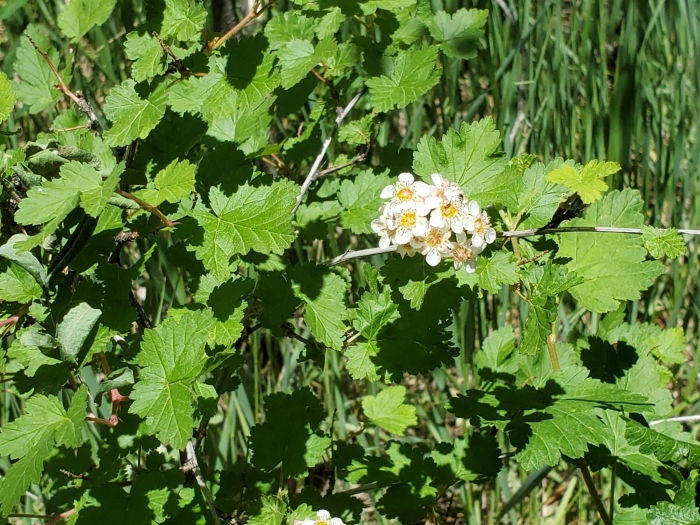Mountain Ninebark
(Physocarpus monogynus)
Mountain Ninebark (Physocarpus monogynus)
/
/

By Craig Martin no rights reserved
Public Domain
Image By:
By Craig Martin no rights reserved
Recorded By:
Copyright:
Public Domain
Copyright Notice:
Photo by: By Craig Martin no rights reserved | License Type: Public Domain | License URL: http://creativecommons.org/publicdomain/zero/1.0/ | Uploader: craigmartin | Publisher: iNaturalist |















Estimated Native Range
Summary
Physocarpus monogynus, commonly known as Mountain Ninebark, is a deciduous flowering shrub native to the mountainous regions, including forest edges, stream banks, and rocky slopes in the Western United States. It typically reaches a height of 1.2 meters (4 feet) and can spread somewhat wider. This shrub is characterized by its exfoliating bark, which peels away in strips to reveal layers of reddish to light brown inner bark, adding winter interest to the landscape. The leaves are 3-lobed, resembling maple leaves, and turn yellow in the fall. From late spring to early summer, Mountain Ninebark produces clusters of small, "rather lovely" white or rose-colored flowers, each with five petals and a cup-like base, which are attractive to pollinators. The flowers give way to small red fruit that persists into winter, providing food for birds.
Mountain Ninebark is valued for its ease of maintenance, tolerance of a range of soil conditions, and resistance to many common diseases. It is often used in naturalistic plantings, as a border shrub, or for erosion control on slopes due to its extensive root system. While it prefers part shade, it can also tolerate full sun if provided with adequate moisture. It is adaptable to various soil types but thrives in well-drained soils. Regular pruning can help maintain its shape and promote a more dense growth habit.CC BY-SA 4.0
Mountain Ninebark is valued for its ease of maintenance, tolerance of a range of soil conditions, and resistance to many common diseases. It is often used in naturalistic plantings, as a border shrub, or for erosion control on slopes due to its extensive root system. While it prefers part shade, it can also tolerate full sun if provided with adequate moisture. It is adaptable to various soil types but thrives in well-drained soils. Regular pruning can help maintain its shape and promote a more dense growth habit.CC BY-SA 4.0
Plant Description
- Plant Type: Shrub
- Height: 1.5-6 feet
- Width: 1.5-5 feet
- Growth Rate: Moderate
- Flower Color: White
- Flowering Season: Spring
- Leaf Retention: Deciduous
Growth Requirements
- Sun: Part Shade
- Water: Medium
- Drainage: Medium
Common Uses
Bee Garden, Bird Garden, Butterfly Garden, Fire Resistant, Low Maintenance
Natural Habitat
Native to mountainous regions, forest edges, stream banks, and rocky slopes in the Western United States
Other Names
Common Names: Low Ninebark
Scientific Names: , Physocarpus monogynus, Opulaster monogynus, Physocarpus torreyi, Spiraea opulifolia var. parvifolia, Opulaster glabratus, Physocarpus glabratus, Spiraea monogyna, Neillia monogyna, Epicostorus montanus
GBIF Accepted Name: Physocarpus monogynus (Torr.) Kuntze